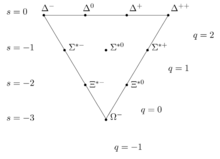Isotopic spin was known from the nuclear physics observations, that the spin 1/2 proton and neutron also had an isotopic spin. This drew the attention to the special unitary group SU(2) and special unitary groups in general.
It became apparent with the results of scattering experiments that resonances appearing in the scattering of protons by pions and kaons could be classified in some representation of the SU(3) group.
The organizational system got the zen name " eightfold way" and was all the rage when I was a graduate student back in 1962.
In addition to organizing the mesons and spin-1/2 baryons into an octet, the principles of the Eightfold Way also applied to the spin-3/2 baryons, forming a decuplet. However, one of the particles of this decuplet had never been previously observed. Gell-Mann called this particle the Ω− and predicted in 1962 that it would have a strangeness −3, electric charge −1 and a mass near 1,680 MeV/c2. In 1964, a particle closely matching these predictions was discovered1 by a particle accelerator group at Brookhaven.

It very soon led to the proposal of the quark model by Gellman and Zweig, but the group classification and the data which led to it preceded the quark model, including the observation of the delta++.
The truth be told, it was the observation of how beautifully the resonance data of the baryons could be organized into representations of SU(3) that led to the three quark model of the baryons. When one has 2 basic units one can have an SU(2) symmetry as was the case of isotopic spin symmetry. When one has SU(3) the expectation of 3 units participating is almost inevitable, when thinking out of the box.
